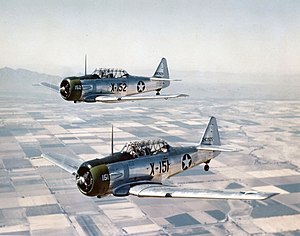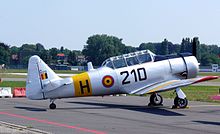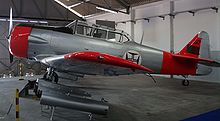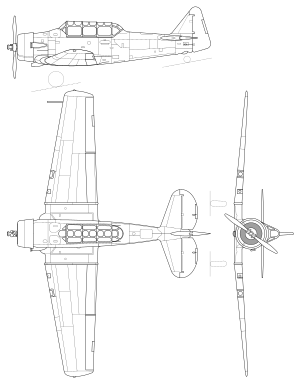North American T-6 Texan
| T-6 Texan/SNJ/Harvard | |
|---|---|

| |
| USAAF AT-6Cs near Luke Field, 1943 | |
| Role | Trainer aircraft |
| National origin | United States |
| Manufacturer | North American Aviation |
| First flight | 1 April 1935 |
| Retired | 1995 (South African Air Force) |
| Primary users | United States Army Air Forces United States Navy Royal Air Force Royal Canadian Air Force |
| Number built | 15,495 |
| Developed from | North American NA-16 |
| Variants | North American A-27 Bacon Super T-6 |
| Developed into | North American P-64 CAC Wirraway |
The North American Aviation T-6 Texan is an American single-engined advanced
Development




The Texan's ancestry goes back to the
Modified as the NA-26, it was submitted as an entry for a USAAC "Basic Combat Trainer " aircraft competition in March 1937. Based on the NA-18, but with a foot longer wingspan, it was the first of the NA-16 series with retractable gear. It was similar to the BT-9, but with a larger engine, the 550 hp (410 kW) Pratt & Whitney R-1340 Wasp, and could accommodate two .30 in (7.62 mm) guns.
With minor alterations, 177 unarmed NA-36s would enter service as the BC-1 with a R-1340-47 engine from 9 June 1937. Roughly 30 were modified as BC-1-I instrument trainers. The BC-1A (NA-55-1) followed as an armed version, primarily for Air Corps Reserve and National Guard units, and the 83 built could be equipped with a .30 in (7.62 mm) machine gun on the nose, and a flexible gun in the rear cockpit.
The US Navy received 40 NA-28 aircraft based on the BT-9, which it designated the NJ-1, as well as 16 NA-52s, designated the SNJ-1, 36 NA-65 as SNJ-2s, and 25 NA-79 also as SNJ-2s.[1]: 33–44, 214
In March 1937, the Commonwealth Aircraft Corporation of Australia purchased an NA-32 (NA-16-1A, with fixed undercarriage) and an NA-33 (NA-16-2K with retractible undercarriage) along with a manufacturing license. The first CAC Wirraway, based on the NA-33, flew on 27 March 1939, of which 755 were built.[1]: 52–53
In August 1937,
According to Dan Hagedorn, "the BC-1A series may be regarded as the true beginning of the modern AT-6 series." In December 1938, the British Commonwealth started receiving the first of 400 Harvard Mark Is (NA-49), for use in the Central Flying School. They were powered by the 600 hp (450 kW) Pratt & Whitney R-1340-S3H1 Wasp. In May 1939, the Royal Canadian Air Force (RCAF) ordered 30 Harvard Mark Is (NA-61). Then in November 1939, the British Purchasing Commission ordered the first of eventually 1275 Harvard Mark IIs (NA-66, NA-75, NA-76, and NA-81) for the Royal Air Force and RCAF.[1]: 46, 63–66, 69, 77–79, 92, 214
On 23 April 1939, NAA received a contract for 251 BT-14s and 94 AT-6s. The BT-14 (NA-58) was a fixed gear aircraft with a metal skinned fuselage 14 inches longer than the BT-9. In 1941, 27 BT-14s were refitted with the 400 hp (300 kW) R-985-11, and designated as BT-14A-NAs. In June 1939, NAA received an order for 94 AT-6-NAs (NA-59), powered by the wright R-1340-47 and able to mount two .30 in (7.62 mm) machines guns.[1]: 46–47, 73–74, 214
The USAAC AT-6A, and the U.S. Navy SNJ-3, were based on the NA-77 and NA-78 designs.
The AT-6B (NA-84) was built for armament training, and could mount a .30 in (7.62 mm) machine gun on the right nose cowl, right wing, and in the rear cockpit, and could carry a light bomb rack. The aircraft was powered by the 600 hp (450 kW) R-1340-AN-1 engine. The USAAC received 400.[1]: 93–97, 214
The NA-88 design was used to build 2970 AT-6Cs (747 of which went to the British Commonwealth as Harvard IIas), 2401 SNJ-4s, 2604 AT-6Ds (537 of which went to the British Commonwealth as Harvard IIIs), and 1357 SNJ-5s. The first AT-6C aircraft was delivered on 12 February 1942. The 12-volt electrical system was changed to a 24-volt system in the AT-6D, for standardization amongst the service. The AT-6D, which was also armament capable, and early versions included a wing gun camera, and a high-pressure
From 1942, Canada's Noorduyn built 2557 R-1340-AN-1-powered Harvard IIs under license, paid for by USAAF Lend-Lease funds as the AT-16, but designated as the Harvard II.B. After WWII, many remained in service with the RCAF.[1]: 122–124
The NA-168 series consisted of remanufactured AT-6s and SNJs for the
The
In April 1951, the USAF ordered an additional 107 T-6Gs for the MDAP, designated NA-188. They placed an order for 11 training aircraft in March 1952, designated NA-195, and then a final batch of 110 aircraft in June for MDAP, designated NA-197.[1]: 155–159, 214
Operational history

The aircraft was mainly used for training, however in many cases it was also repurposed into combat roles. The aircraft served in a great many air forces around the world in the mid to late 20th century. After serving in air forces, it also went on to be displayed at air shows and museums as a warbird.
Combat use
The British used Harvards during World War II in North Africa, but not in a combat role. They were used extensively for preparing pilots in theatre for flying US aircraft types, whose handling and controls differed from British aircraft.
No. 74 Operational Training Unit (OTU) was formed at
Peru used its seven T-6 fighter bombers in the
The


The
During the Korean War and, to a lesser extent, the Vietnam War, T-6s were pressed into service as forward air control aircraft. These aircraft were designated T-6 "Mosquitos".[4][5][1]: 148–151
The T-6G was also used in a light attack or counterinsurgency role by France during the Algerian War in special Escadrilles d'Aviation Légère d'Appui (EALA), armed with machine guns, bombs and rockets. At its peak, 38 EALAs were active. The largest unit was the Groupe d'Aviation Légère d'Appui 72, which consisted of up to 21 EALAs.
From 1961 to 1975, Portugal used more than a hundred T-6Gs, also in the counterinsurgency role, during the Portuguese Colonial War. During this war, almost all the Portuguese Air Force bases and air fields in Angola, Mozambique, and Portuguese Guinea had a detachment of T-6Gs.
On 16 June 1955, rebel Argentine Navy SNJ-4s
In 1957–58, the
The
The South African Air Force received their first T-6s in October 1942 to be used by the Joint Air Training Scheme. By July 1944, 633 Harvard Mk IIA T-6s and IIIs had been shipped to South Africa with another 555 (379 MkIIAs and 176 Mk IIIs) to arrive by October 1945. Another 65 (AT-6Ds and 30 T-6Gs) were ordered between 1952 and 1956.[7] The aircraft also saw some action during the South African Border war. The T-6 remained in service until 1995 as a basic trainer, mainly as a result of the United Nations arms embargo against South Africa's apartheid policies. They were replaced by Pilatus PC-7 MkII turboprop trainers.[8]
Research testbed
The Harvard 4 has been used in Canada as a testbed aircraft for evaluating cockpit attitude displays. Its aerobatic capability permits the instructor pilot to maneuver the aircraft into unusual attitudes, then turn the craft over to an evaluator pilot in the "blind" rear cockpit to recover, based on one of several digitally generated attitude displays.[9]
Variants
Operators

- Argentine Army Aviation (SNJ-4)
- Argentine Naval Aviation (SNJ-4 and 30 SNJ-5Cs for carrier operations)

 Biafra
Biafra
- Biafran Air Force[10]
- Bolivian Air Force
- Naval Aviation
- Royal Khmer Aviation (AVRK)
- Royal Canadian Air Force
- Royal Canadian Navy
- National Research Council(still in use)
- Colombian Air Force
- Cuban Air and Air Defense Force

- Dominican Air Force
- Air Force of El Salvador
- French Air Force[11]
- Gabon Air Force

- German Air Force (Bundeswehr Luftwaffe)
- Haitian Air Corps
- Indonesian Air Force – bought 25 from the United States.
- Iraqi Air Force - bought 15 aircraft in the early 1950s; 6 of them were donated to Lebanon in 1956.[12]
- Italian Air Force operated 238 aircraft from 1949 until 1979[13]

- Force Aérienne Katangaise[14]
- Mexican Air Force Total of 120 delivered, 47 AT-6 and 73 T-6C
- Royal Netherlands Air Force
- Dutch Naval Aviation Service
- Royal Netherlands East Indies Army Air Force – Post war
- Mozambique Air and Air Defense Forces
- Royal New Zealand Air Force (1 maintained for historic flight)
- New Zealand Territorial Air Force

- Royal Norwegian Air Force (1 maintained for historic flight)
- Fuerza Aérea de Nicaragua (G.N) Escuela Militar de Aviación 1948-1979
- Paraguayan Air Force
- Paraguayan Naval Aviation

- Southern Rhodesian Air Force
- Republic of Vietnam Air Force
- Spanish Air Force[16]
- Swedish Air Force 145 Harvard IIb as Sk 16A, 106 T-6A, T-6B, SNJ-3, SNJ-4 as Sk 16B and 6 SNJ-2 as Sk 16C.


- Turkish Air Force: 196 planes of various types
- Royal Air Force
- Royal Navy
- Qinetiq (retired in 2016)[17][18]
- United States Army Air Corps/Army Air Forces
- United States Air Force
- United States Navy
- United States Marine Corps
- United States Coast Guard
- SFR Yugoslav Air Force
Specifications (T-6G)

Data from Jane's Fighting Aircraft of World War II.[20]
General characteristics
- Crew: two (student and instructor)
- Length: 29 ft (8.8 m)
- Wingspan: 42 ft (13 m)
- Height: 11 ft 8 in (3.56 m)
- Wing area: 253.7 sq ft (23.57 m2)
- Empty weight: 4,158 lb (1,886 kg)
- Gross weight: 5,617 lb (2,548 kg)
- Powerplant: 1 × Pratt & Whitney R-1340-AN-1 Wasp radial engine, 600 hp (450 kW)
Performance
- Maximum speed: 208 mph (335 km/h, 181 kn) at 5000 ft (1,500 m)
- Cruise speed: 145 mph (233 km/h, 126 kn)
- Range: 730 mi (1,170 km, 630 nmi)
- Service ceiling: 24,200 ft (7,400 m)
- Rate of climb: 1,200 ft/min (6.1 m/s)
- Wing loading: 22.2 lb/sq ft (108 kg/m2)
- Power/mass: 0.11 hp/lb (kW/kg)
Armament
- Provision for up to 3 × 0.30 in (7.62 mm) machine guns
In popular culture

In the September 1944 issue of The Sportsman Pilot,
After World War II, the National Air Races established a unique racing class for the AT-6/Texan/Harvard aircraft; this class continues today at the Reno National Air Races each year.
Since the Second World War, the T-6 has been a regular participant at
The T-6 had a major role in the Pat Benatar music video for the song "Shadows of the Night". It was also used for a backdrop on the album cover of the 1978 Black Sabbath album Never Say Die!
The New Zealand Warbirds "Roaring 40s" aerobatic team use ex–Royal New Zealand Air Force Harvards. The Flying Lions Aerobatic Team uses Harvards acquired from the South African Air Force.[21]
See also
- T-6 Texan variants
- T-6 Texan II
Related development
- North American NA-16
- North American BT-9
- North American NA-64 Yale
- North American A-27
- North American P-64
- CAC Wirraway
Aircraft of comparable role, configuration, and era
- Arado Ar 96
- Fiat G.49
- Kyushu K10W
- FMA I.Ae. 22 DL
- Macchi MB.323
- Miles Master
- Percival Provost
- Piaggio P.150
- Soko 522
- Valmet Vihuri
- VL Pyry
- Yakovlev Yak-11
- PZL TS-8 Bies
Related lists
- List of aircraft of World War II
- List of military aircraft of the United States
- List of aircraft of the RAF
- List of aircraft of the RNZAF
References
- ^ a b c d e f g h i j k l m n o p Hagedorn, 2009
- ^ Hagedorn, 1997, pp.34-35
- ^ Nicolle, David. "Syria's Fighting Texans". ACIG.org. Retrieved 30 January 2013.
- ^ "AF Museum – North American T-6D "Mosquito"". National Museum of the US Air Force. Retrieved 4 October 2015.
- ^ "North American AT-6/SNJ-6". Lyon Air Museum. Archived from the original on 22 September 2019. Retrieved 18 September 2019.
- ^ Cooper, Tom. "Argentina, 1955–1965". ACIG.org. Retrieved 23 January 2013.
- ^ "The South African Air Force". www.saairforce.co.za. Retrieved 25 June 2020.
- ^ "The History of the SAAF". www.af.mil.za. Archived from the original on 5 May 2012. Retrieved 12 November 2009.
- ^ http://archive.nrc-cnrc.gc.ca/obj/iar-ira/doc/harvard_eng.pdf[permanent dead link]
- ISBN 978-1472816092.
- ^ Cooper & Grandolini 2018, p. 23
- ISBN 978-1-913118-74-7.
- ^ "Italian Air Force Aircraft Types". www.aeroflight.co.uk.
- ^ "Congo, Part 1; 1960–1963". ACIG. 2003. Retrieved 9 August 2013.
- ^ Cooper & Grandolini 2018, pp. 30–31
- ^ Cooper & Grandolini 2018, pp. 25, V
- ^ KF183 Retrieved 8 March 2017
- ^ Qinetiq's Last Harvard Departs Air Forces Monthly p8 January 2017
- ISBN 978-1-912174-23-2.
- ISBN 1 85170 493 0.
- ^ "Team fact sheet" (PDF). Eqstra.co.za. Archived from the original (PDF) on 24 March 2014. Retrieved 23 March 2014.
Bibliography
- Becker, Dave and Brent, Winston. AT-6 Harvard in South African Service (African Aviation Series No.1). Nelspruit, South Africa:, Freeworld Publications CC, 2000. ISBN 0-9583880-2-4.
- Bergèse, Francis. North American T-6 (in French). Rennes, France: Ouest France, 1979. ISBN 2-85882-183-6.
- Cooper, Tom; Grandolini, Albert (2018). Showdown in Western Sahara, Volume 1: Air Warfare over the Last African Colony, 1945-1975. Warwick, UK: Helion & Company Publishing. ISBN 978-1-912390-35-9.
- "Courrier des Lecteurs" [Readers' Letters]. Avions: Toute l'Aéronautique et son histoire (in French). No. 109. April 2002. p. 3. ISSN 1243-8650.
- Cortet, Pierre (January 1998). "Du NA-16 au T-6: les biplaces d'entrainement North American: première époque: les trains fixes" [From NA-16 to T-6: The North American Two-seat Trainer: The Fixed-gear Era]. Avions: Toute l'aéronautique et son histoire (in French). No. 58. pp. 32–37. ISSN 1243-8650.
- Cortet, Pierre (February 1998). "Du NA-16 au T-6: les biplaces d'entrainement North American: première époque: les trains fixes (2e partie)". Avions: Toute l'aéronautique et son histoire (in French). No. 59. pp. 28–35. ISSN 1243-8650.
- Cortet, Pierre (March 1998). "Du NA-16 au T-6: les biplaces d'entrainement North American: première époque: les trains fixes (3e partie)". Avions: Toute l'aéronautique et son histoire (in French). No. 60. pp. 37–42. ISSN 1243-8650.
- Cortet, Pierre (April 1998). "Du NA-16 au T-6: les biplaces d'entrainement North American: première époque: les trains fixes (4e partie)". Avions: Toute l'aéronautique et son histoire (in French). No. 61. pp. 32–34. ISSN 1243-8650.
- Cortet, Pierre (May 1998). "Du NA-16 au T-6: les biplaces d'entrainement North American: première époque: les trains fixes (5e partie: les NA-57 en France)" [From NA-16 to T-6: The North American Two-seat Trainer: The Fixed-gear Era (The NA-57 in France)]. Avions: Toute l'aéronautique et son histoire (in French). No. 62. pp. 22–29. ISSN 1243-8650.
- Cortet, Pierre (January 1998). "Du NA-16 au T-6: les biplaces d'entrainement North American: première époque: les trains fixes (6ème partie: les NA-57 de Vichy et de la France Libre)" [From NA-16 to T-6: The North American Two-seat Trainer: The Fixed-gear Era (The NA-57s of Vichy and Free France]. Avions: Toute l'aéronautique et son histoire (in French). No. 58. pp. 31–37. ISSN 1243-8650.
- Cortet, Pierre (July 1998). "Du NA-16 au T-6: les biplaces d'entrainement North American: première époque: à train fixe (dernière partie)". Avions: Toute l'aéronautique et son histoire (in French). No. 64. pp. 30–34. ISSN 1243-8650.
- Davis, Larry. T-6 Texan in Action (Aircraft Number 94). Carrollton, TX: Squadron/Signal Publications, Inc., 1989. ISBN 0-89747-224-1.
- Donald, David. American Warplanes of World War II. London:Aerospace Publishing, 1995. ISBN 1-874023-72-7.
- Fletcher, David C. and MacPhail, Doug. Harvard! the North American Trainers in Canada. San Josef, BC/Dundee, Ont: DCF Flying Books, 1990. ISBN 0-9693825-0-2.
- Hagedorn, Dan (1997). North American NA-16/AT-6/SNJ. North Branch, MN: Specialty Press. ISBN 0-933424-76-0..
- Hagedorn, Dan (2009). North American's T-6: a definitive history of the world's most famous trainer. North Branch, MN: Specialty Press. ISBN 9781580071246.
- Hamlin, John F. The Harvard File. Tonbridge, Kent, UK: Air-Britain (Historians) Ltd., 1988. ISBN 0-85130-160-6.
- Jesse. William. T-6 Texan, the Immortal Pilot Trainer. London: Osprey Publishing Ltd., 1991. ISBN 1-85532-154-8.
- Kohn, Leo J. The Story of the Texan (American Flight Manuals). Aviation Publications Co., 1975. ISBN 0-87994-034-4.
- MacPhail, Doug and Östberg, Mikael. Triple Crown BT-9: The ASJA/Saab Sk 14, A Pictorial Essay (in English/Swedish). San Josef, BC/Dundee, Ont: DCF Flying Books, 2003.
- Marchand, Patrick and Takamori, Junko. North American T-6 et derivés (in French). Le Muy, France: Editions d'Along, 2004. ISBN 2-914403-21-6.
- Morgan, Len. Famous Aircraft Series: The AT-6 Harvard. New York: Arco Publishing Co., 1965.
- Nicolle, David (December 1997). "Texans sur l'arabe: la 1ère victoire aérienne syrienne" [Texans over Arabia: The First Syrian Aerial Victory]. Avions: Toute l'aéronautique et son histoire (in French). No. 57. pp. 9–13. ISSN 1243-8650.
- Olrich, Walter and Ethell, Jeffrey L. Pilot maker; the Incredible T-6. North Branch, MN: Specialty Press, 1982. ISBN 0-933424-34-5.
- "Pentagon Over the Islands: The Thirty-Year History of Indonesian Military Aviation". Air Enthusiast Quarterly. No. 2. n.d. pp. 154–162. ISSN 0143-5450.
- Sapienza, Antonio Luis (January 1997). "Les North American T-6 "Texan" de la Force Aérienne Paraguayenne, de 1943 à nos jours" [North American T-6 Texans of the Paraguayan Air Force from 1943 to Today]. Avions: Toute l'aéronautique et son histoire (in French). No. 46. pp. 15–17. ISSN 1243-8650.
- Smith, Peter Charles. North American T-6: SNJ, Harvard and Wirraway. Ramsbury, Marlborough, Wiltshire, UK: The Crowood Press Ltd., 2000. ISBN 1-86126-382-1.
- Smith, Peter Charles. T-6: The Harvard, Texan & Wirraway – A Pictorial Record. North Branch, MN: Speciality Press, 1995. ISBN 0-7603-0191-3.
- Sonck, Jean-Pierre (January 2002). "1964: l'ONU au Congo" [The United Nations in the Congo, 1964]. Avions: Toute l'Aéronautique et son histoire (in French). No. 106. pp. 31–36. ISSN 1243-8650.
- Sonck, Jean-Pierre (February 2002). "1964: l'ONU au Congo". Avions: Toute l'Aéronautique et son histoire (in French). No. 107. pp. 33–38. ISSN 1243-8650.
- Spring, Ivan and Rivers, Reg. Colour schemes and special markings of the North American "Harvard" in service with the SAAF 1940 to 1995. Pretoria, SOuth Africa: Spring Air Publishers, 1996. ISBN 0-9583977-3-2.
- Starkings, Peter. From American Acorn to Japanese Oak – The tale of an unsung Japanese training aircraft with roots extending across the Pacific Ocean. Arawasi International, Asahi Process, September–December 2007, Issue 7.
- Swanborough, Gordon and Bowers, Peter M. United States Military Aircraft since 1909. London:Putnam, 1963.
- Vidal, João M. (September–October 1996). "Texans in Biafra: T-6Gs in Use in the Nigerian Civil War". Air Enthusiast. No. 65. pp. 40–47. ISSN 0143-5450.
- Wache, Siegfried. CCF Harvard Mk. IV (T-6) (series F-40 – Die Flugzeuge der Bundeswehr Nr.09) (in German). Buchholz, Germany: Buchholz Medien Verlag, 1989. ISBN 3-935761-09-0.
- Young, Edward M. (1984). "France's Forgotten Air War". ISSN 0143-5450.
External links
- Warbird Alley: T-6/SNJ/Harvard page – History, photos, specs, and links
- Texan, Harvard & SNJ Registry – Lists approximately 1,200 extant T-6's by serial number
- The Canadian Harvard Aircraft Association
- Backgrounder on the Harvard 4 (includes photographs)
- AT-6: School Marm With an Attitude (pilot report)
- "A Yank at Grantham: First North American "Basic" Trainer Delivered to the R.A.F. : The Harvard Described"Flight 1939 Archived 3 November 2012 at the Wayback Machine
- T.O. TT-6C-2 Handbook Erection and Maintenance Instructions T-6, -6A, 6B USAF Model T-6C, T-6D Navy Models SNJ-3, SNJ-4, SNJ-5, SNJ-6[permanent dead link] (1956)
- Pacific Warbirds: North American SNJ Archived 12 October 2016 at the Wayback Machine – History, restoration, service & more
